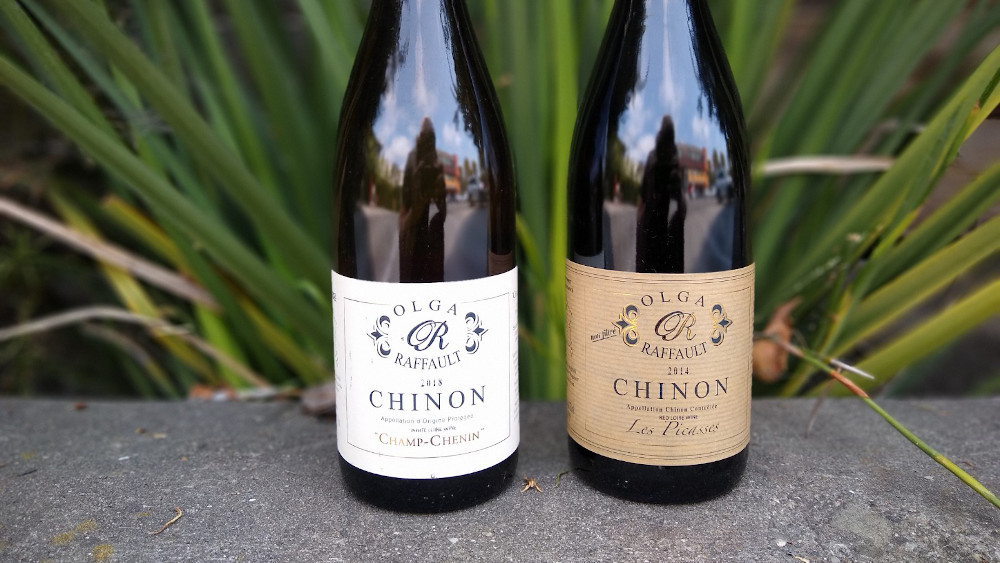The fertile French terrain situated at the confluence of the Loire and the Vienne has been producing wine for hundreds of years. Established in 1937, the Chinon AOC lies on the south bank of the Loire, bisected by the Vienne in the westernmost reaches of Touraine. Chinon is almost exclusively the province of cabernet franc, a grape that seems to thrive in the region’s terroir.

Two offerings from Domaine Olga Raffault
Domaine Olga Raffault is perched on the bucolic triangle of land known as the Véron, between the two rivers just east of where they converge. The Raffault family has been making wine in Chinon for five generations. Tragedy struck in 1947 when Olga’s husband and partner, Pierre, died suddenly, leaving Olga and her two children to fend for themselves.
According to family legend, it was one of the estate’s employees, Ernest Zenninger, who vowed to the dying Pierre he’d look after his family. A repentant former German soldier, Zenninger was grateful for the kindness the Raffaults had shown him and would from that point on dedicate his life to the family business. Zenninger became the estate’s winemaker, mentoring Olga’s son Jean along the way, and together Jean and Ernest would help solidify Olga Raffault’s status as a Loire Valley legend.

Image sourced from olga-raffault.com
Today, the venerable house is operated by Olga’s granddaughter Sylvie and her husband, Eric de la Vigerie, with able assistance from their son, Arnaud. They have recently converted to organic farming in their vineyards, where they pick all the grapes by hand, using native yeasts for fermentation. Working with vines in some of Chinon’s most desirable terrain, Domaine Olga Raffault remains one of the appellation’s benchmark producers.
Raffault’s flagship bottling is the Les Picasses cuvee, 100 percent cabernet franc from a south-facing slope on the north bank of the Vienne. The vines are more than 50 years old and feed off a mixture of alluvial clay and chalky limestone. After fermentation in stainless steel, it’s aged for roughly 18 months in relatively large barrels and then aged in tank and bottle for a few more years before release.
The resulting wine is incredibly balanced and complex–ample-bodied, rich with dark fruit and plush tannins, earthy but with plenty of acidity and a mineral edge. Think cassoulet, braised oxtails, roasted lamb, or similarly robust fare. Next time you’re considering a Bordeaux, reach for this instead. At less than $40 a bottle, Raffault’s Les Picasses is still one of the Loire’s great value plays.
I wrote earlier that Chinon is almost exclusively the province of cabernet franc, and while that’s true, there is a negligible amount of chenin blanc planted there. Thankfully, one of Raffault’s 24 hectares of vineyards is dedicated to chenin, the plot of land that produces the wonderful Champ-Chenin cuvee.
In its youth, this wine definitely plays hard to get; there’s just a tantalizing hint of the pome-fruit fleshiness that has yet to fully emerge. But you can tell it’s coming. Even with the fruit still somewhat subdued, there’s enough depth, vitality, and sophistication to satisfy even the most impatient among us. No malo or wood here, just some lees-aging to give it a bit of texture. Cellar-worthy, indeed.
Both the 2014 Les Picasses and the 2018 Champ-Chenin are currently available at Paul Marcus Wines. They are drinking beautifully now, but their best years are still ahead of them. If you’re interested in Chinon wines, you should probably get to know Domaine Olga Raffault.


Leave a Reply
Want to join the discussion?Feel free to contribute!